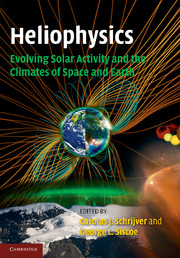Book contents
- Frontmatter
- Contents
- Preface
- 1 Interconnectedness in heliophysics
- 2 Long-term evolution of magnetic activity of Sun-like stars
- 3 Formation and early evolution of stars and protoplanetary disks
- 4 Planetary habitability on astronomical time scales
- 5 Solar internal flows and dynamo action
- 6 Modeling solar and stellar dynamos
- 7 Planetary fields and dynamos
- 8 The structure and evolution of the three-dimensional solar wind
- 9 The heliosphere and cosmic rays
- 10 Solar spectral irradiance: measurements and models
- 11 Astrophysical influences on planetary climate systems
- 12 Assessing the Sun–climate relationship in paleoclimate records
- 13 Terrestrial ionospheres
- 14 Long-term evolution of the geospace climate
- 15 Waves and transport processes in atmospheres and oceans
- 16 Solar variability, climate, and atmospheric photochemistry
- Appendix I Authors and editors
- List of illustrations
- List of tables
- References
- Index
- Plates
10 - Solar spectral irradiance: measurements and models
Published online by Cambridge University Press: 05 April 2013
- Frontmatter
- Contents
- Preface
- 1 Interconnectedness in heliophysics
- 2 Long-term evolution of magnetic activity of Sun-like stars
- 3 Formation and early evolution of stars and protoplanetary disks
- 4 Planetary habitability on astronomical time scales
- 5 Solar internal flows and dynamo action
- 6 Modeling solar and stellar dynamos
- 7 Planetary fields and dynamos
- 8 The structure and evolution of the three-dimensional solar wind
- 9 The heliosphere and cosmic rays
- 10 Solar spectral irradiance: measurements and models
- 11 Astrophysical influences on planetary climate systems
- 12 Assessing the Sun–climate relationship in paleoclimate records
- 13 Terrestrial ionospheres
- 14 Long-term evolution of the geospace climate
- 15 Waves and transport processes in atmospheres and oceans
- 16 Solar variability, climate, and atmospheric photochemistry
- Appendix I Authors and editors
- List of illustrations
- List of tables
- References
- Index
- Plates
Summary
Introduction
Solar photons are Earth's primary energy source: Earth is habitable only because the Sun shines, radiating energy throughout the entire heliosphere. The Sun shines because its surface, warmed by energy produced in its nuclear burning core (Bahcall, 2000), is hotter (5770 K) than the surrounding cosmos (4 K). Electromagnetic energy traveling radially outward from the Sun illuminates the heliosphere with a flux of photons that diminishes inversely with the square of increasing distance. Earth, which has only an insignificant internal energy source (see Section 7.4.1), intercepts solar radiant energy, collecting photons emitted from all locations of the solar disk. Unimpeded in their journey to Earth, solar photons take eight minutes to establish the fastest and most direct of all Sun–Earth connections.
The photon energy incident on the Earth at its average distance from the Sun of one astronomical unit (AU), and prior to absorption in the Earth's atmosphere, is called the solar irradiance (e.g. Fröhlich and Lean, 2004). When the energy of the photons is integrated over all wavelengths across the electromagnetic spectrum, the average total solar irradiance is 1361 ± 4W m−2. Solar photons at visible wavelengths have the largest flux (Fig. 10.1) because the emission spectrum of a blackbody near 5770 K peaks in this region. Although really a high temperature plasma, the Sun's “surface” is defined as that layer of the solar atmosphere for which optical depth is unity for photons near 500 nm (cf. Vol. I, chapter 8).
- Type
- Chapter
- Information
- Publisher: Cambridge University PressPrint publication year: 2010
- 13
- Cited by



